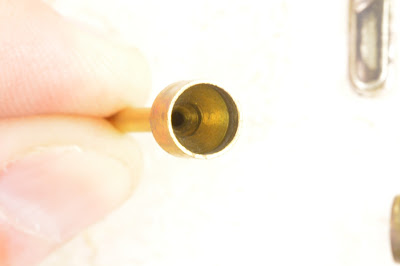This article has been edited and included in The Leadhead's Pencil Blog Volume 4; copies are available print on demand through Amazon here, and I offer an ebook version in pdf format at the Legendary Lead Company here.
If you don't want the book but you enjoy this article, please consider supporting the Blog project here.
The very, very first ones, the ones Charles Keeran had in his sales bag when he set up a trial counter at Wanamaker’s department store just before Christmas,1913, had a “fibrous” plug at the tip end with a hole drilled in it, made of some as yet unknown material which was just flexible enough that it would grip a piece of lead but still allow it to pass through.
I wrote a few articles recently about those very first Eversharps,(see “What the Very First Eversharps Looked Like” at http://leadheadpencils.blogspot.com/2013/06/what-very-first-ever-sharps-looked-like.html). Here’s patent number 1,130,741:
Keeran’s metal “rifled” tip came later – but not much later. He filed his application for patent number 1,151,016 on October 28, 1914, and the drawings show that the metal tip was screwed into a metal tube which extended back to that threaded insert:
These early examples are too rare for me to take apart, but as I was going through some things at the museum the other day, I ran across a “Wahl Ever Sharp” pencil which, from the use of three words on the imprint, indicates it was made sometime in 1917 – using Keeran’s 1914 specifications (except for the clip, which was patented by John Wahl to replace the Heath patent clip Wahl wasn’t allowed to use and Keeran’s labor-intensive “trowel clip” of 1916). Since the inside solder weld had failed, I was able to take it completely apart to better show you what’s going on in these:
At the top, here’s something a lot of people don’t know: that bushing is there so that you can pull off the cap to reveal an eraser, or unscrew the cap (which also unscrews the bushing) to access spare leads:
In later incarnations of the Eversharp, the threaded insert and the metal nose section were a one-piece affair, but on these early ones, the threaded insert is just a straight tube with threading on the inside to engage the mechanism:
The insert was held in place by a soft solder that would melt at low temperatures, and you can see the residue on this insert where it once was adhered to the inside of the barrel:
The nose section is essentially a funnel, through which lead falls down to the tip as the pencil is being loaded:
At the end of this funnel is a lead plug, the end of which is threaded to receive the rifled tip:
Since that funnel is the same diameter as the threaded insert which is soldered in place behind it, once it’s in there, there’s no way for it to come out unless the insert is desoldered and extracted. And that simple fact is what makes tomorrow’s story so interesting . . .
The link to the next part of this story is here.








No comments:
Post a Comment